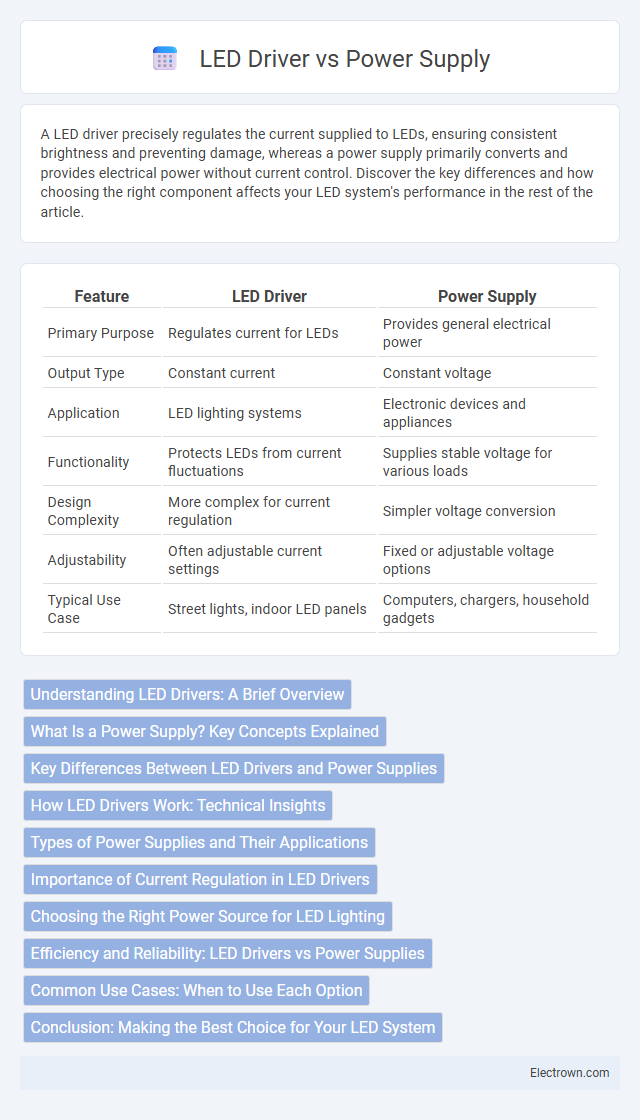A LED driver precisely regulates the current supplied to LEDs, ensuring consistent brightness and preventing damage, whereas a power supply primarily converts and provides electrical power without current control. Discover the key differences and how choosing the right component affects your LED system's performance in the rest of the article.
Table of Comparison
| Feature | LED Driver | Power Supply |
|---|---|---|
| Primary Purpose | Regulates current for LEDs | Provides general electrical power |
| Output Type | Constant current | Constant voltage |
| Application | LED lighting systems | Electronic devices and appliances |
| Functionality | Protects LEDs from current fluctuations | Supplies stable voltage for various loads |
| Design Complexity | More complex for current regulation | Simpler voltage conversion |
| Adjustability | Often adjustable current settings | Fixed or adjustable voltage options |
| Typical Use Case | Street lights, indoor LED panels | Computers, chargers, household gadgets |
Understanding LED Drivers: A Brief Overview
LED drivers regulate the current flowing through LED lighting systems, ensuring stable brightness and preventing damage caused by fluctuations. Unlike general power supplies that provide a constant voltage output, LED drivers deliver a constant current tailored to the LED's specific requirements. This precision in current control enhances LED efficiency, lifespan, and performance in various applications.
What Is a Power Supply? Key Concepts Explained
A power supply is an electrical device that converts AC voltage from the mains into a stable DC voltage suitable for electronic devices, including LED lighting systems. Unlike LED drivers, which specifically regulate current for LEDs, power supplies provide a constant voltage output without adjusting current levels. Understanding your power supply's voltage and current ratings is crucial for compatibility and safety in any electrical project.
Key Differences Between LED Drivers and Power Supplies
LED drivers regulate current to ensure consistent LED performance and prevent damage from voltage fluctuations, while power supplies primarily provide a fixed voltage output for general electrical devices. The key difference lies in the LED driver's ability to adjust and maintain a constant current, crucial for LED longevity and brightness control, whereas power supplies deliver consistent voltage without current regulation. Understanding these distinctions helps you select the proper component for efficient and safe LED operation.
How LED Drivers Work: Technical Insights
LED drivers regulate the current flowing through LEDs by converting higher input voltages to a constant current output, ensuring stable performance and preventing damage. Unlike standard power supplies that deliver a fixed voltage, LED drivers adjust voltage dynamically to maintain consistent LED brightness and efficiency. Understanding how your LED driver manages current and voltage fluctuations is crucial for optimal LED lifespan and lighting quality.
Types of Power Supplies and Their Applications
LED drivers are specialized power supplies designed to regulate current for LED lighting, while general power supplies may provide fixed voltage or current outputs for various electronics. Types of power supplies include linear, switching, and constant current supplies, each suited for different applications such as LED strips, industrial equipment, or consumer devices. Your choice depends on factors like voltage requirements, efficiency, and the need for stable current to ensure optimal LED performance and longevity.
Importance of Current Regulation in LED Drivers
LED drivers regulate current precisely to ensure optimal performance and longevity of your LED lights, preventing fluctuations that can cause flickering or damage. Unlike general power supplies that provide constant voltage, LED drivers deliver a consistent current tailored for LEDs, enhancing energy efficiency and reliability. Proper current regulation minimizes thermal stress and maintains consistent brightness, making it crucial for safe and effective LED operation.
Choosing the Right Power Source for LED Lighting
Selecting the right power source for LED lighting hinges on understanding the distinction between LED drivers and regular power supplies. LED drivers provide constant current output tailored to the specific voltage and current requirements of LED fixtures, ensuring optimal performance and longevity. Power supplies, typically offering constant voltage, may not adequately protect LEDs from current fluctuations, potentially causing reduced efficiency or premature failure.
Efficiency and Reliability: LED Drivers vs Power Supplies
LED drivers are specifically designed to regulate current and voltage for LED lighting, offering higher efficiency by minimizing energy loss during operation compared to general power supplies. Their built-in protection features, such as overcurrent, thermal, and short-circuit safeguards, enhance reliability and extend the lifespan of LED systems. Conventional power supplies may lack these specialized controls, leading to less stable performance and potential damage to sensitive LED components.
Common Use Cases: When to Use Each Option
LED drivers are ideal for powering LEDs in applications requiring constant current, such as in commercial lighting, outdoor displays, and automotive headlights, ensuring consistent brightness and longevity. Power supplies are better suited for general electrical devices where constant voltage is needed, including household appliances and electronic gadgets. Choosing between an LED driver and power supply depends on whether the LED system demands precise current regulation or simply a stable voltage source for operation.
Conclusion: Making the Best Choice for Your LED System
Choosing between an LED driver and a power supply depends on your LED system's specific requirements. LED drivers provide regulated current essential for LED longevity and performance, while power supplies deliver general voltage without current regulation, suitable for non-constant current applications. Ensuring your LED setup matches the driver capabilities optimizes efficiency, brightness, and lifespan, giving you reliable and high-quality lighting results.
led driver vs power supply Infographic

 electrown.com
electrown.com